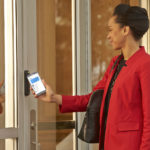 I recently shared a couple of posts about the break away / break out mode on automatic sliding doors (post 1, post 2), and it’s time to tackle another aspect of the egress requirements for these doors. Although there is a section in the I-Codes dedicated to automatic doors, it is not the only section that applies to sliding doors in a means of egress. The section of the International Building Code (IBC) called Power-Operated Doors (2021 edition: 1010.3.2) addresses the allowable forces to open and close the doors manually, the ANSI/BHMA standards automatic doors are required to meet, and a few exceptions. This section does not address the hardware used for security and egress – locks, latches, and special locking arrangements are covered in other sections of the model codes.
I recently shared a couple of posts about the break away / break out mode on automatic sliding doors (post 1, post 2), and it’s time to tackle another aspect of the egress requirements for these doors. Although there is a section in the I-Codes dedicated to automatic doors, it is not the only section that applies to sliding doors in a means of egress. The section of the International Building Code (IBC) called Power-Operated Doors (2021 edition: 1010.3.2) addresses the allowable forces to open and close the doors manually, the ANSI/BHMA standards automatic doors are required to meet, and a few exceptions. This section does not address the hardware used for security and egress – locks, latches, and special locking arrangements are covered in other sections of the model codes.
So what types of locking hardware might be used on an automatic sliding door in a means of egress, and how do the codes affect product selection? Typically, an automatic sliding door that requires a locking mechanism will have one of the following types of hardware. It would not normally be acceptable to have more than one lock on a door, for example, a hook bolt and panic hardware, as one motion must unlatch all of the locks and latches on the door simultaneously. And remember, these doors will likely need the break away / break out feature in order to be code-compliant.
- Hook bolt with cylinder outside, thumbturn inside – The key cylinder and thumbturn are used to project or retract the bolt, which controls whether the door can slide open. This type of lock would have to meet the requirements for deadbolts in a means of egress:
- The application must be one where panic hardware is not required.
- The door would not be able to be fire-rated (unless it’s the entrance door to a dwelling unit or sleeping unit, or other location where two releasing operations are allowed – not applicable to automatic sliding doors).
- The deadbolt must be the only locking/latching device on the door (unless it’s the entrance door to a dwelling unit or sleeping unit, or other location where two releasing operations are allowed – not applicable to automatic sliding doors).
- The thumbturn and cylinder would have to be between 34 inches and 48 inches above the floor, or as required by the adopted codes.
- The thumbturn must be operable without tight grasping, pinching, or twisting of the wrist.
- Double-cylinder hook bolt – In the model codes, these locks are called key-operated locks. A key cylinder on both sides can be used to project or retract the hook bolt, which controls whether or not the door can slide open. Key-operated locks are allowed by the I-Codes on a building’s main entrance door(s) and tenant entrance door(s), where certain requirements are met (the NFPA requirements are similar – refer to the adopted code):
- The use group must be one of the following:
- Assembly occupancy with an occupant load of 300 people or less,
- Business, factory, mercantile, or storage occupancy, or
- A place of religious worship.
- The locking device must be readily distinguishable as locked – typically the lock will have an indicator which reads “open” or “locked.”
- Signage on the egress side of the door or adjacent to the door must state “THIS DOOR TO REMAIN UNLOCKED WHEN THIS SPACE IS OCCUPIED.” The letters on the sign must be at least 1 inch high on a contrasting background. This signage serves as a reminder to employees, but also advises the public that the door must be unlocked when they are present.
- A building official may revoke the use of a key-operated lock for due cause.
- The use group must be one of the following:
- Panic hardware – Depending on the use group or occupancy classification and the calculated occupant load of a space, doors in the means of egress from that area may require panic hardware. The specifics depend on the adopted code:
- I-Codes: Each door in a means of egress equipped with a lock or latch, serving assembly (Group A) or educational (Group E) occupancies with a calculated occupant load of 50 people or more, and high hazard (Group H) occupancies of any occupant load.
- NFPA Codes: Required means of egress doors equipped with a lock or latch, serving assembly, educational, or day care occupancies with a calculated occupant load of 100 people or more, and areas of high hazard contents with a calculated occupant load in excess of 5.
- Note that the double-cylinder / key-operated lock described above may be allowed as an alternative to panic hardware (not in addition to panic hardware) if certain criteria are met.
- Access control / free egress – When a door is equipped with electrified hardware that controls access but does not affect egress, it must meet the same requirements that apply to mechanical hardware:
- The door must unlatch with one releasing motion for egress (with some exceptions).
- Egress must require no key, tool, special knowledge or effort.
- Operation of the door hardware must require no tight grasping, pinching, or twisting of the wrist.
- Operable force for the hardware must be within the limits of the applicable code or standard.
- Releasing hardware must be mounted between 34-48 inches above the floor, or as required by the adopted code.
- Special locking arrangements – When a door is equipped with electrified hardware that may affect egress, it is considered a special locking arrangement. Not all of these applications are commonly used on automatic sliding doors, but special locking arrangements include:
- Electrified lock with sensor release – Typically applies to electromagnetic locks – a sensor releases the electrified lock for egress when a building occupant is detected on the egress side of the door.
- Electrified lock with door hardware release – Also typically applies to electromagnetic locks – a switch in the door-mounted hardware releases the electrified lock for egress.
- Delayed egress lock – Delays egress for 15 seconds but allows immediate egress upon fire alarm and power failure.
- Controlled egress in health care facilities – Prevents egress until released by staff or an emergency override.
- Elevator lobby exit access doors – Controls access to tenant spaces but allows egress during a fire alarm or power failure.
- Stairwell reentry – Allows building occupants to leave a stairwell if it becomes compromised during a fire.
If you have questions about the code requirements for automatic sliding doors, leave them in the comments and I’ll answer them in future posts!
You need to login or register to bookmark/favorite this content.










Should code language be added, requiring signage on both inside and outside,,, along the lines of:::
“ No obstructions allowed with in XX feet of dooor”
So if people need to use the break away, the doors will fully open, and not hit something?
Charles, You bring up a very good point…not a code requirement but a very good point.
Well I need to look at the code book,,,
But off the top, if the breakaway feature is used,,,, you are required to have the required door width, like any other door.
Made me look:::
2018 ibc
1010.1.4.2 Power-Operated Doors
Exception 3
For a biparting door in the emergency breakout mode, a door leaf located within a multiple-leaf opening shall be exempt from the minimum 32-inch (813 mm) single-leaf requirement of Section 1010.1.1, provided that a minimum 32-inch (813 mm) clear opening is provided when the two biparting leaves meeting in the center are broken out.
Is the exit motion detector a specific code requirement or can the exit motion be replaced with an exit button?
Mike,
When it comes to releasing “Electrically locked egress doors” (I believe these types of doors would fall into that category) there is NO provision for releasing the door with an egress button. Unless that button is affixed to the door itself (IBC2021 1010.2.11)
According to IBC 2021 there are 2 categories these types of doors fall under “Door hardware released of electrically locked egress doors (IBC2021 1010.2.11) Which means the release switch is mounted to the door (typically in the form of an RX switch concealed in the operating hardware) or Sensor released of electrically locked egress doors (IBC 2021 1010.2.12)
-Mark
Good video
https://idighardware.com/2023/09/qq-break-out-break-away/
One more
https://idighardware.com/2020/09/ww-no-break-away/#